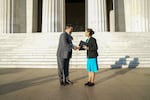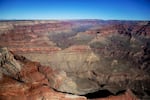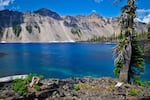
Charles "Chuck" Sams shakes hands with Interior Secretary Deb Haaland after being sworn in as the next director of the National Park Service at the Lincoln Memorial in Washington, D.C., Dec. 16, 2021.
U.S. Department of the Interior / Heilemann
Charles F. “Chuck” Sams III shook Interior Secretary Deb Haaland’s hand moments after she officially made Sams the next director of the National Park Service on the sunbathed steps of the Lincoln Memorial in mid-December.
It was a historic moment: the United States’ first Native American cabinet member, Haaland, who is a member of the Pueblo of Laguna, swearing in Sams, enrolled Cayuse and Walla Walla with the Confederated Tribes of the Umatilla Indian Reservation, as the first Native American to lead one of the nation’s foremost public lands agencies.
The significance was not lost on Sams, who spoke recently with OPB.
“I’m so happy and I’m so grateful to President Biden for nominating me to be the 19th director of the National Park Service,” Sams said, “and to continue on in my stewardship responsibilities as an American Indian.”
Sams is the first permanent director of the park service since 2017. He enters the office as the country has made a pair of enormous investments in the park system to clear a hefty maintenance backlog and bolster national parks, monuments and memorials for a growing crush of visitors.
Related: What the Great American Outdoors Act could do for Oregon
Among his top priorities as director, Sams said, is to put money directed to the park service from the Great American Outdoors Act and the recently passed Infrastructure Investment and Jobs Act to good use.
“We’re just very excited to be able to take the investments from the American people and put those on the ground so that we can ensure that parks are here for the next seven generations,” Sams said.
OPB environment reporter Monica Samayoa spoke with Sams about his plans for the park service, overcrowding on public lands and his first-ever trip to a national park.
Monica Samayoa: So your confirmation has been a cause of celebration because you are the first Native American to lead the park service. What does that mean to you?
Chuck Sams: I couldn’t ask for a better opportunity to serve the United States than in national parks. National parks are America’s treasure, America’s gem. Since the founding of the parks in 1916 there has been a dedicated staff who have done that stewardship and continue to do that stewardship. And it really aligns with my values as an American Indian and my values as an American citizen.
Samayoa: I want to talk about your relationship with national parks growing up as a Native American and as an Oregonian.
Sams: My parents regularly took us on summer vacation to Arizona where my mother’s people are from. My mother is Cocopah from southwest Arizona near the town of Somerton, and, of course, I grew up here in Eastern Oregon on the Umatilla Indian Reservation. … I can look back at age 4 or 5 and remember probably the first national park I was able to go to was Grand Canyon. Since then I’ve been to well over 125 parks across the United States and U.S. territories. And so I’ve had a wonderful relationship of being able to walk into the footsteps of my fellow Americans, whether that was the Seminole Indians in Florida and the Everglades, or whether that was Union or Confederate soldiers on a number of battlefields between Maine and Florida itself — in addition to walking in my ancestors’ own homelands here in Oregon, down in the John Day Fossil Beds or at Crater Lake.

The Grand Canyon National Park is covered in the morning sunlight as seen from a helicopter near Tusayan, Ariz., on Oct. 5, 2013.
Julie Jacobson / AP
Samayoa: You shared with us that your first experience at a national park was the Grand Canyon. Can you tell us what that feeling was when you first stepped foot in that national park?
Sams: Just looking at that huge canyon and recognizing the grandeur and the beauty and how small we are, what a great, immense responsibility we have as American Indians to be stewards of our resources. My own creation story — whether that is here among the Umatilla, Walla Walla and Cayuse or the Cocopah people — tells us that we are supposed to protect these lands and these resources for the next seven generations. And so seeing that and being able to travel to a number of national parks, it invigorates me and excites me to join such a dedicated staff who do that stewardship.
Samayoa: Can we talk a little bit more about your priorities now that you are the director of the National Park Service?
Sams: I’m very appreciative of the House and Senate passing the Great American Outdoors Act and the bipartisan infrastructure law. Both of those bring resources to the table that allow us to [take on] a number of issues and infrastructure build-up. National parks have over 5,000 miles of roads and over [1,400] bridges. Many of those have a backlog of issues that need to be addressed so that they can get up to standard. This funding allows us to do that. … I want to be able to prove to the American people that those investments are going to be made soundly as we are able to put that money on the ground across all 50 states and U.S. territories. In addition, I want to help prepare for the growing workforce. As you probably know, the National Park Service [staffing] is down by 20% and yet we’ve seen a 20% increase in people coming into national parks — well over 300 million visitors a year. And so I want to look out and make sure that we are making investments into the next generation of stewards and making sure that workforce is diverse and reflects Americans across the spectrum.
Related: How wilderness permits change the wilderness experience
Samayoa: You just mentioned there’s a 20% increase of people just flocking to national parks, especially over the past year. How are you going to balance overcrowding problems and still encourage all Americans to visit public parks without “loving them to death”?
Sams: First, I want to applaud what has been done in the past couple years with the national park staff, who have come up with innovative ways, whether that is timed entry or figuring out how to use new technology to bus people in and shuttle them in and around the parks. But what may work at Acadia is not necessarily what’s gonna work at Yosemite. What works down in the Everglades may not necessarily work at Zion or Denali. And so we really have to work very closely with the local communities to help address these issues, especially the gateway communities and how we can ensure that folks still have equal and open access to the parks and yet that we are not loving them to death. I mean it’s a good problem to have, don’t get me wrong, but we have to find that balance so that we can ensure that what we’re stewarding will be here for the next seven generations ahead.

Crater Lake is pictured in an undated file photo.
Vince Patton / OPB
Samayoa: You also mentioned encouraging other communities that are not as engaged with parks. How will you work with those communities?
Sams: I want to sit down and talk with them so that we can see what those realities are and see where we can help and make sure that those resources are available so that they aren’t excluded from being able to get into those national parks. National parks fees are localized. The majority of that funding where parks do charge a fee goes right back into helping maintain that park. But we also want to make sure that we don’t price anyone out in America to be able to get into their national parks. And so those are conversations that we’re definitely going to be having across the United States.
Related: Racism in the great outdoors: Oregon's natural spaces feel off limits to Black people
Samayoa: So I want to switch into talking about climate change and how it’s altering our national parks. I’m curious how this is informing the way you plan to serve as a steward for these treasured places.
Sams: I think that we can look at our national parks as still some of the strongest anchors on being able to do climate adaptation and fight climate change. That being said, of course, they’re also some of the first places that we see that are being affected — whether that is Denali and the road closures up there due to landslides because of permafrost actually becoming defrosted, whether that is the drought that we’re experiencing at Lake Mead and how the water affects recreation and water needs and uses throughout the West. This administration, the Biden-Harris administration, is committed to fighting and figuring out how we can do climate adaptation. National Park Service staff regularly steward those resources so well that I think that we can be the model for a number of federal agencies and federal land managers to help in figuring out best practices, best management and also the things that we didn’t do well so that we can go out and see how climate adaptation can affect and build a stronger and more resilient United States.
Samayoa: Is there anything else you’d like to share with us on what we can expect from you and the National Park Service within the next year?
Sams: As an Oregonian, I’m very proud to be able to serve at a national level to help and inspire my fellow Oregonians to be out there and be the strong stewards, and to inspire Indian Country that they have a steward here in this chair and that we will continue to fulfill our responsibilities of making sure that the landscape is not only protected, preserved, but also enhanced in the way that will be here for future folks to be able to enjoy and recreate in.
This interview has been edited and condensed for clarity. Interview by Monica Samayoa. Additional reporting and writing by Bradley W. Parks.

